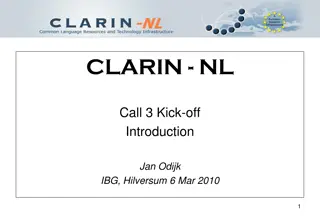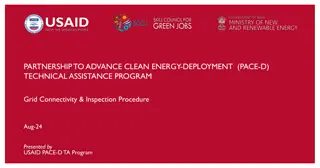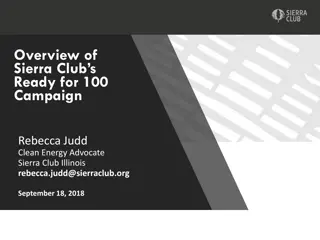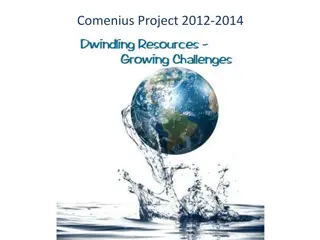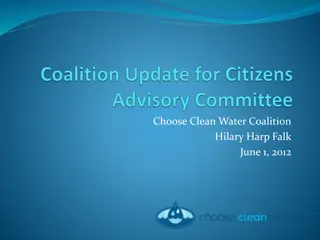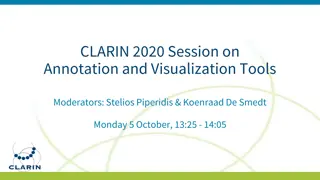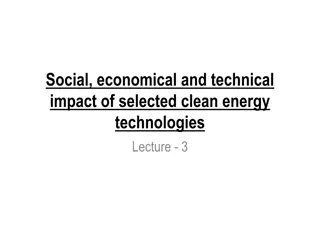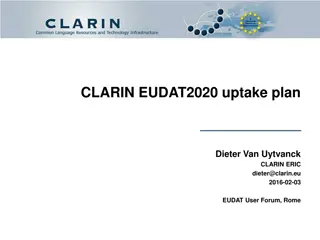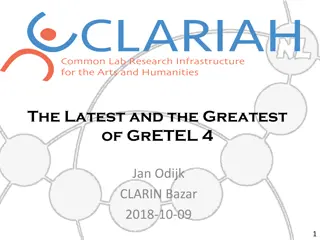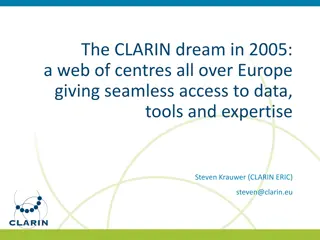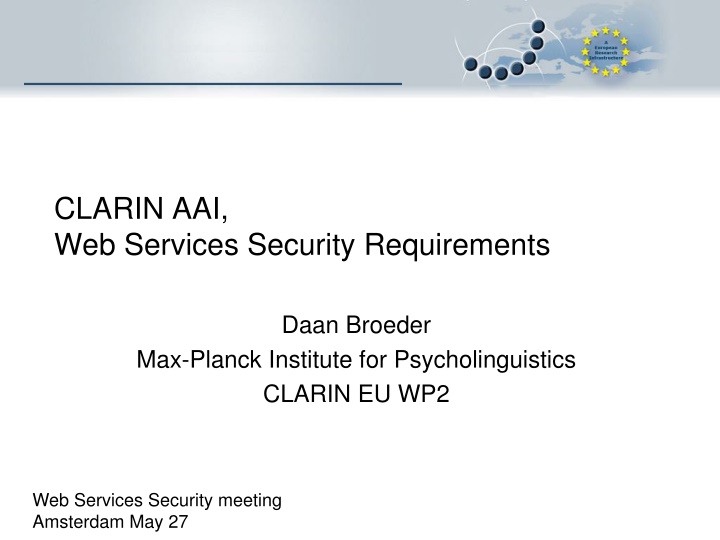
CLARIN Project: Advancing Language Resources and Technology
Discover the CLARIN project, a pan-European initiative aimed at providing language resources and technology for researchers in the fields of Language & SSH. Learn about the organization, funding, and goals of CLARIN, as well as its Holy Grail use case and efforts in EU-wide federated authentication. Explore how CLARIN is shaping the future of language research through collaboration and innovation in web services security.
Download Presentation

Please find below an Image/Link to download the presentation.
The content on the website is provided AS IS for your information and personal use only. It may not be sold, licensed, or shared on other websites without obtaining consent from the author. If you encounter any issues during the download, it is possible that the publisher has removed the file from their server.
You are allowed to download the files provided on this website for personal or commercial use, subject to the condition that they are used lawfully. All files are the property of their respective owners.
The content on the website is provided AS IS for your information and personal use only. It may not be sold, licensed, or shared on other websites without obtaining consent from the author.
E N D
Presentation Transcript
CLARIN AAI, Web Services Security Requirements Daan Broeder Max-Planck Institute for Psycholinguistics CLARIN EU WP2 Web Services Security meeting Amsterdam May 27
What is CLARIN The CLARIN project is a large-scale pan-European collaborative effort to create, coordinate and make language resources and technology available and readily useable for Language & SSH (Social Sciences & Humanities) researchers. Resources: Lexica, text corpora, multi-media/multi-modal recordings, Technology: parsers, speech recognizers, editors, Ever more often available as web services
CLARIN Organization CLARIN is an EU Infrastructure project with 4.2 ME funding for a 3 year preparatory phase started in 2008. Additional funding from national governments, currently at least 16 ME The CLARIN consortium has now 32 partners from 26 EU countries and 132 member organizations CLARIN EU continuation after the preparatory phase likely as an ERIC This is important if only to provide a legal entity that is able to make contracts with outside parties on behalf of the CLARIN community.
CLARIN Holy Grail Use Case A researcher authenticates at his own organization and creates a virtual collection of resources from different repositories. He does this on the basis of browsing a catalogue, searching through metadata, or searching in resource content. He is then able to use a workflow specification tool and have a workflow engine process this virtual collection using reliable distributed web services which he is authorized to use. After evaluation resulting data (including metadata) can be added to a repository setting proper and checked ownership information.
CLARIN AAI It looks that EU wide federated authentication will be solved either by: A future GEANT eduGain solution (confederation of national Identity Federations) Creating CLARIN SP federation and making contracts with the individual IDFs Current state of affairs, CLARIN test federation was successfully demonstrated. However three problems remain unsolved Homeless users. CLARIN members with no national IDF For true SSO functionality requires the CLARIN users to have CLARIN specific user attributes that no IdP will support. E.g. EULA signing Authentication for web services
WS Security/delegation Simple example IdP AS distributed web- services SOAP & REST Auth info federated authentication WS Security should be Not too complex not too many different systems maintainable WS Web App delegation (distributed) web-services repository
WS Security/delegation for workflows Authorization records are not shown delegation dataflow tokenizer federated authentication parserA Composite Web service Web App WF engine parser parserB semantic tagger repository (distributed) web-services
Workflow AAI scenario The web application controlling the workflow engine functions as a SP and allows federated login. The workflow engine can send messages to other web services that assert, with sufficient certainty that the workflow engine acts on behalf of the user. Every web service is then itself capable of performing the same action again: delegating the authority of the user.
Solutions? always trust the web service rule. Any registered web service should be trusted if it claims to act on behalf of a specific user. web services identify each other by means of server certificates, user identity itself is not proven solution for a relatively limited number of web services, not a scalable solution. Embody the identity (and thus the authority) of the user in a user certificate (upload, SLCS, ) certificate is then propagated from web service to web service. Use SAML assertions especially the Relayed-Trust (RT) SAML assertion. the workflow engine will use the original authentication assertion it obtained from and build a RT SAML assertion that is specific for itself and the web service it needs to access
Thank you for your attention CLARIN has received funding from the European Community's Seventh Framework Programme under grant agreement n 212230



